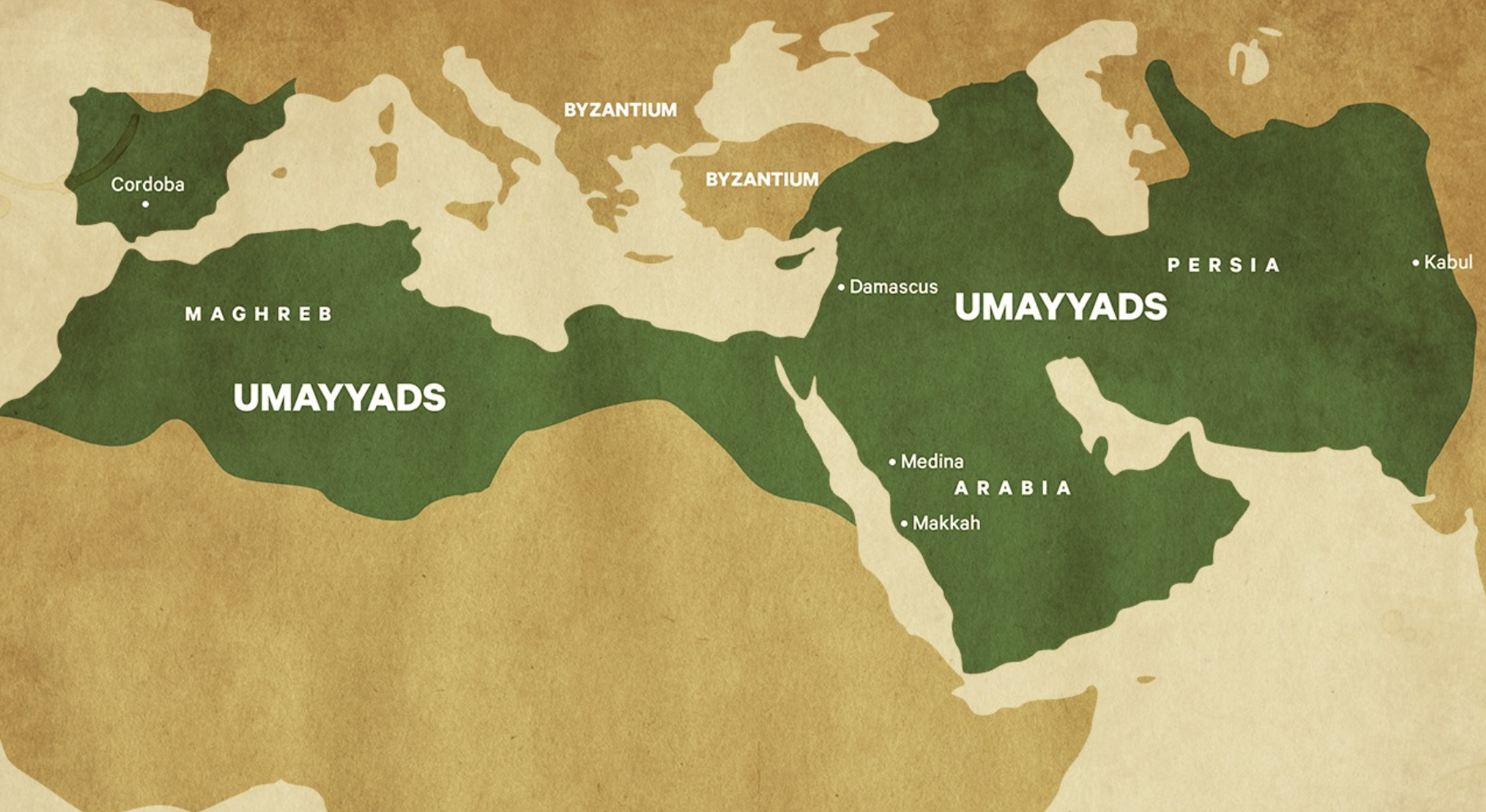In the Name of Allah, The Most Gracious, The Most Merciful
The farther back you look, the further ahead you can see. In the last article, we explored the evolution of usul al-fiqh over time. In this article, we delve into how the two mainstream groups of fiqh evolved and examine the socio-political and geopolitical factors that contributed to this evolution.
Introduction
In the annals of Islamic history, a pivotal era unfolds—the epoch of the Umayyad dynasty. This dynasty held power for approximately a century, commencing right after the reign of ‘Alee ibn Abee Taalib (radiallahuanhum). The Umayyad dynasty persisted around until the mid-eighth century CE.

During this period, Muslims underwent significant territorial expansion, necessitating the widespread dissemination of knowledge in the newly acquired regions. Simultaneously, this era also bore witness to socio-political upheavals, most notably the rebellions of the Khawaarij and the Shia. The constant vying of these factions for control of the government resulted in a general state of turmoil.
In response to the expansion of regions and escalating political tensions, many companions and their students strategically dispersed from the political centers of the state to propagate Islam and the teachings of our Prophet (ﷺ). This dispersion, coupled with the rise of different factions, complicated the process of achieving Ijmaa’ (consensus). Consequently, individual Ijtihaads of scholars gained prominence, leading to the emergence of various schools of Islamic law (Madh-habs), as mentioned in the previous article.
Fabrication of Hadith
The narration of Hadeeths also increased during this period, driven by the growing need for information. Scholars sought authentic and saheeh narrations (ahadith) to make legal judgments, leading to the compilation of Hadeeths. However, this period also witnessed a significant increase in false narrators of hadiths and false narrations being attributed to the Prophet (ﷺ), prompting the development of the science of Mustalah Hadith.
Ahlul Hadith and Ahlur Rai
During this early period of the Umayyad dynasty, Fiqh scholars underwent a division into two primary groups: Ahl ar-Ra’i (people of Iraq) and Ahl al-Hadeeth (people of Hijaz). We delved into these groups in our previous blog. It is important to understand some of the geo politcal factors that led to this divide, some of which are outlined below. To provide context regarding the considerable distance between these two regions, here is a simple google search.

Remember, this was an era devoid of cars, flights, or trains. People had to spend days or even months to cover these vast distances. Traveling such vast distances was far from simple, and recognizing this will help in understanding how the knowledge divide originated.
1) Shift in Capital: After the time of the last Righteous Caliph, ‘Alee ibn Abee Taalib (radiallahuanhum), the Islamic state's capital moved from Iraq to Syria. This shift spared the Hijaz from external influences.
2) Abundance of Hadeeths: The region of Hijaz boasted an abundance of Hadeeths and legal rulings due to the presence of companions and their students in this region.
3) Iraq's Cultural Mix: In contrast, Iraq, as a new and unfamiliar land for Muslims, became a melting pot of cultures after becoming the capital. This led to novel situations unfamiliar to scholars.
4) Limited Presence of Sahaabah: Due to vast number of Sahaabah being present in the region of Hijaz and the great distance between (Makkah/Madinah) and Kufa, hadeeths were not as readily accessible as in the region of Hijaz.
5) Fabrication in Iraq: Unfortunately, Iraq became a hub for fabricated Hadeeth and early deviant sects.
6) Dependency on Qiyaas (Analogical Reasoning): Scholars in Iraq, lacking a reliable pool of authentic Hadeeth, leaned more on reason and logic. They relied on Hadeeth to a lesser extent than scholars in the Hijaz.
7) Evolution of Iraqi School: The Iraqi school of thought evolved to prioritize reason and logic over the narrated Sunnah of the Prophet (ﷺ).
Difference In The Methodology of Ahlul Hadith and Ahlur Rai
With that said, let's delve into a detailed exploration of the distinctions between these groups.
| Aspect | Ahlul Hadith | Ahlur Rai |
|---|---|---|
| How to find solution to issue when it arises? | Combine all evidences in the Quran, Sunnah, and Athaar of Sahabah to reach the solution. (Shah Waliullah, Hujjatullahil Baligah 1/129) | Solve issues by making istikhraaj (comparison) with any Fiqhi decision or principle from an earlier Mujtahid Faqeeh from Ahlur Rai and bring out various branches with the help of Qiyas (analogical method). |
| When to do Qiyas? | Ijtihad and Qiyas will be in a state of necessity and emergency (in absence of Quran, Sunnah, or Athaar of Sahabah). (Imam Abu Hanifa, by Abu Zahrah p 157) | Ijtihad and Qiyas will be in every situation, and it is a permanent thing. (Imam Abu Hanifa, by Abu Zahrah p 157) |
| Khabar Ahad vs Qiyas | Hadith is proof in itself and belief. | Sometimes they will favor the Qiyas over the Ahad narrations (Al-Milal wan Nihal of al-Shahrastani 1/206) |
| Hypothetical issues | It is not permissible to make ijtihad until a problem has arisen, because ijtihad is permissible under necessity, so unless there is a need, it is not required. (Tareekh Fiqh al-Islami by al-Ashqar p 82, Tareekh Tashreeh al-Islami al-Qattan p 291) | Qiyas and Ijtihad are permissible and recommended in hypothetical issues. For example, if a man's milk comes out and he feeds a child, does this prove breastfeeding or not? (Al-Fatawa al-Hindiyyah, Fath al-Qadir Sharh al-Hidayah) |
| Is Ijtihaad binding? | The ijtihadat or jurisprudence of an imam or jurist is not binding as a law. | Ijtihad of Imam can be enforced as law, and other imams, mujtahids, or scholars or followers of religions and traditions can be made bound or forced to follow a certain jurisprudence by legislation. |
| Takhsees using Khabr Ahad | It is permissible to make Takhsees (specification) of Quran using Khabr Ahad. Hadith can also explain the vague meaning of general Quranic ayah. (Al-Risalah, Kitab al-Umm of Shafiee) | Ahlur Rai allows the Quran to be general in its generality and does not make Takhsees of it from Khabr Wahid. (Imam Abu Hanifa by Abu Zahrah) |
| Narration of Contrary Views | Ahlul Hadith narrate what is for them as well as what is against them and decide the stronger position. (Al-Daraqutni in Sunan and others) | After deciding Masail based on Takhreej of Usool of Imam, they only narrate reports which are for them (even if it is weak). |
| Mutamad Position in Furoo | Ahlul Hadith do not have a set "Mutamad" position in issues of Furoo. Scholars can reach a conclusion after weighing evidences. | Ahlur Rai (Hanafis, later Shafis, later Malikis, and later Hanbalis) have a Mutamad position in their madhahib, and one has to follow that "Mutamad" position of the madhab. |
The difference in the methodology can be classified into the following aspects:
- How to find solution to issue when it arises?
- When to do Qiyas?
- Khabar Ahad vs Qiyas
- Hypothetical issues
- Is Ijtihaad binding?
- Takhsees using Khabr Ahad
- Narration of Contrary Views
- Mutamad Position in Furoo
It is important to note that Imam Abu Hanifa rahimahullah is a distinguished scholar from Ahlul Sunnah wal Jama'ah, undisputedly recognized as the Imam of Muslims. We are focusing on delving into the distinctions in methodology, particularly in the realm of Fiqh, examining how rulings are derived, without any criticism aimed at any group.
1) How to find solution to issue when it arises?
Clarification: When learning Fiqh, one needs to understand how people derive rulings. Among Ahlul Hadith, they are adherents of Ahlul Sunnah. Among Ahlul Rai, there are some who follow Ahlul Sunnah and others who adhere to Ahlul Bida. For instance, Bishr al-Marisi's followers, who are leaders in Ahlul Bida, belong to Ahlul Rai. Bishr al-Marisi himself was a Mu'tazili, denying all attributes of Allah. It's crucial to recognize that categorizing all of Ahlul Bida or Ahlul Rai under a single umbrella is an oversimplification.
Methodology: Now, let's concentrate on the two approaches. Imam Shah Waliullah Muhaddis Dahlawi explains the methodologies of Ahlul Hadith and Ahlul Rai in his work.
Scenario: Suppose you have an issue or a mas'ala. What would scholars of Ahlul Hadith and Ahlul Rai do in such a situation?
Ahlul Hadith's Approach:
- Combine evidence from Quran, Sunnah, and the statements and actions of Sahaba.
- Weigh and evaluate all evidence to reach a conclusion.
Ahlul Rai's Approach:
- Utilize the method of istikhraj based on the fatwas of Imam Abu Hanifa and how his students approached similar issues in the past. "Istikhraj" refers to the process of extracting or deriving legal rulings or principles from various sources, often in Islamic jurisprudence (fiqh).
- Derive principles from the scholars' answers.
- Apply these principles to new issues and, if needed, support them with relevant Hadith or athar.
2) When to do Qiyas?
Definition: Qiyas refers to analogical reasoning. Future blogs will covers this topic in detail inshaAllah.
Ahlul Hadith's Approach:
- Reserved for situations of necessity or emergency.
- Only employed when there's an absence of Quranic ayah, sunnah, athar of Sahaba, ijma, or any other viable option.
- Viewed as a last resort.
Ahlul Rai's Approach:
- Applied in every situation.
- Perceived as a permanent feature of their methodology.
- This stance is highlighted by various scholars, including Abu Zahra in his work on the Hanafi Madhab.
Supporting Explanation by Ibn al-Qayyim:
- In his work on Usul al-Fiqh, "Alam wal Mawqaeen (اعلام الموقعين)," Ibn al-Qayyim emphasizes the obligation of performing ijtihad and qiyas during times of need.
- Compares the permissibility of qiyas to the allowance of certain actions, such as consuming meat from dead animals or blood, for someone in a state of need.
- Asserts that qiyas becomes permissible only when there is a genuine necessity.
3) Khabar Ahad vs Qiyas
Definition: Another significant disparity between Ahlul Hadith and Ahlul Rai lies in their approach to khabar ahad (singular narrations, explained inshaAllah in upcoming blog posts), particularly ahad ahadith, and the use of qiyas.
Ahlul Hadith's View:
- Hadith, once established and authenticated (sahih), is considered a proof in itself and a matter of belief.
- Sheikh Albani, rahimahullah, expounds on this in his book, “Hadith is a proof in itself and belief”.
Ahlul Rai's View:
- Not uniformly inclined towards accepting singular narrations (ahad ahadith).
- At times, they may prioritize qiyas over ahad narrations.
- This perspective is partly rooted in the scarcity of mutawwatir ahadith, with the majority of the hadith corpus being ahad narrations, including ghareeb, aziz, and mashroor categories.
Imam Abu Hanifa's Position:
- Imam Abu Hanifa, rahimahullah, is cited as preferring hadith over qiyas in a narration.
- Later Hanafis, however, did not universally adhere to this stance, with some scholars favoring qiyas over ahadith.
Imam Abu Hanifa's Stance, as Narrated:
- Yahya said, I have heard Imam Abu Hanifa saying, ‘I (first of all) seek evidence with Qur’an, and what I do not find in it I seek evidence with Sunnah of the Messenger of Allah. And if I do not find it in either the Book of Allah or the Sunnah of His Messenger then I seek evidence with the sayings of his companions, taking the opinion of whoever I deem fit and leaving that of others and I do not go for any opinion except leaving their opinions. And when it comes to Ibrahim and al-Sha’bi and Ibn Sirin, al-Hasan, ‘Ata’, Sa’id bin al-Musayyib and others who did ijtihad then I also engage in ijtihad as they did. (Tareekh Ibn Maeen 5/504, Saheeh).
Later Hanafi Scholars' Position:
- Notably, some Hanafi scholars, including al-Jassas, Muhammad al-Sarqishi, al-Damusi, al-Ashashi, and al-Bazdawi, tend to favor qiyas over ahadith if it contradicts their madhab. They offer explanations such as the narrator not being faqih to justify their preference for qiyas.
4) Hypothetical issues
An additional dissimilarity between Ahlul Hadith and Ahlul Rai in the realm of Usul al-Fiqh pertains to hypothetical issues.
Ahlul Hadith's Approach:
- Ijtihad is impermissible until a problem has actually arisen.
- Practical situations prompt the need for ijtihad, and answers are provided based on necessity.
- Hypothetical questions are dismissed as irrelevant. For instance, Ahmad ibn Hanbal discouraged questions about situations that do not actually occur.
Ahlul Rai's Approach:
- Even in hypothetical scenarios, qiyas and ijtihad are permissible, and at times, recommended.
- Examples from Hanafi literature, such as Fatawa al-Hindiya and Shar'a of Hidayah, explore hypothetical situations to derive legal rulings.
Sahabah on asking hypothetical questions:
- Ibn Umar said: “Do not ask about that which did not take place, for verily I heard Umar cursing the one who asked about the thing which did not happen.”
- On the authority of Kharijah bin Zaid that whenever someone asked Zaid bin Thaabit a question he would ask: “Did it already happen?” if the answer was in negative, he would say: “Leave it till it actually takes place.”
- On the authority of Masrooq that he asked a question from Ubai bin Ka`b رضي الله عنه . Ubai replied: “Did it take place?” I said: ‘No.” He said: “Leave us till it actually takes place. So when it does happen we would give our verdict to you.”
[al-Faqeeh wal-Mutafaqqih of al-Khateeb al-Baghdadi (2/11-14)]
5) Is Ijtihaad binding?
- Ahlul Hadith holds that ijtihad, not directly derived from Quran or Sunnah, is not binding as law.
- Ahlul Rai, in contrast, believes that the ijtihad of an Imam can be enforced as law, making it obligatory for followers of different traditions to adhere.
Historical Examples:
- Imam Malik opposed the idea of enforcing his Muwatta as a binding law, emphasizing the diversity of views among the companions on secondary matters.
Harun ar-Rashid, the Umayyad caliph, once considered hanging the Muwaṭṭaʾ on the Ka'bah and mandating all Muslims to adhere strictly to it. When he shared this idea with Imām Mālik, the Imam responded, "I advise against this. The Companions of the Messenger of Allah (ṣal Allāhu ʿalaihi wa sallam) held differing views on certain secondary matters, and they dispersed across various regions, yet they were all following the right path." Upon hearing this, Harun ar-Rashid said, "May Allah grant you success, O Abu Abdillah." (Hilyatul awliya 3326)
- In contrast, Hanafi jurisprudence was implemented as civil law in the Ottoman Empire and Egypt (even until 1920), where adherence was mandatory for all citizens.
6) Takhsees using Khabr Ahad
Definition: "Takhsees" (تخصيص) can be translated as "specification" or "particularization" in English. In the context of Islamic jurisprudence (Usul al-Fiqh), takhsees refers to the process of specifying or limiting the general meaning of a legal rule or principle. It involves making a general command or statement more specific by introducing additional conditions or details.
In the realm of Usul al-Fiqh, another point of divergence between Ahlul Hadith and Ahlul Rai is their approach to takhsees, particularly concerning qabar ahad.
Short Understanding Ahadith Categories:
- Ahadith are categorized into two main types: ahadith al-mutawatir and ahadith al-ahad. The latter is further divided into aziz, gharib, and mashur.
- Ahadith al-mutawatir, is a hadith with numerous narrators making fabrication improbable, hence instills certainty.
- Khabar wahid (khabar ahaad), on the other hand, involves a group of narrators witnessing an event but lacks the overwhelming consensus seen in mutawatir.
Ahlul Hadith's Perspective:
- Ahlul Hadith believes in making takhsees using khabar ahad.
- They argue that if a general command in the Quran has a specific hadith associated with it, the hadith can specify and elucidate the general meaning.
- For example, the general command about marriage in the Quran does not explicitly mention the requirement of a guardian (wali). However, a specific hadith states that marriage without a guardian is invalid, leading Ahlul Hadith to make the command specific.
Ahlul Rai's Perspective:
- Ahlul Rai, specifically the Hanafi madhab, opposes making takhsees using qabar ahad.
- They maintain that if the Quran provides a general command, it should remain general unless explicitly specified in another Quranic verse.
- For instance, regarding the requirement of a guardian for marriage, Ahlul Rai argues that the Quran's general statement on marriage does not necessitate the presence of a guardian.
Example of Takhsees:
For instance, consider the following scenario:
- There is a hadith stating that "there is no nikah without a wali" (guardian).
- The Quranic ayah related to marriage is general in its command, not explicitly mentioning the requirement of a guardian.
- According to Ahlul Rai, including the Hanafi madhab, it is not deemed obligatory for an individual to have a guardian for nikah.
- Ahlul Rai argues that a woman can marry even without a guardian, as they perceive the Quranic ayah to be a general statement regarding marriage without specifying the necessity of a wali.
- Their position is rooted in the belief that the Quranic verse is comprehensive and should not be made specific using qabar wahid (singular narrations).
This example illustrates the application of takhsees, where a specific hadith is used to limit or specify the general command in the Quranic ayah related to marriage.
7) Narration of Contrary Views
One another characteristic of Ahlul Hadith, setting them apart from Ahlul Rai, is highlighted by Imam al-Darqutni as "Yanquluna ma lahum wa ma alayhi"
Ahlul Hadith's Approach:
- Ahlul Hadith adopt a comprehensive approach in narration and discussion of issues.
- When presenting an issue, they narrate all relevant hadiths, irrespective of whether they support or oppose their position.
- In the examination of any issue, the books of hadith include both supportive and opposing narrations.
- The aim is to provide a transparent and inclusive account of the narrations surrounding a particular issue.
Illustration of Ahlul Hadith's Methodology:
- For instance, when addressing a specific matter, Ahlul Hadith may present a hadith that aligns with their stance.
- However, they don't shy away from including weaker or opposing hadiths, even if they acknowledge the latter as less robust.
- The decision-making process involves assessing the strength of all narrations, both in favor and against their position.
Ahlul Rai's Approach:
- Ahlul Rai, after conducting takhreej (deduction) based on usool, selectively rely on hadiths.
- They predominantly favor hadiths that align with the conclusions they have reached through their deductive process.
- Hadiths, regardless of their strength or weakness, are mentioned primarily as secondary supports for their already established position.
Conclusion
This was a concise exploration of the evolution of usul al-fiqh over time. If you found it a bit complex, there's no need to worry; it was an introduction to the historical context that precedes this course. InshaAllah, from next week onward, we will delve directly into the subject, and you'll find that things become clearer and more accessible as we progress.
If you like our content, please subscribe to our blog! And Follow us on Instagram or Telegram to stay up to date!





